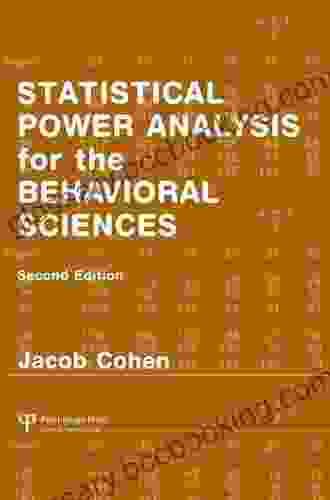Statistical Power Analysis for the Behavioral Sciences: Empowering Your Research

Statistical power analysis is a fundamental aspect of research design for behavioral scientists. It provides a systematic framework for determining the minimum sample size required to detect a statistically significant effect. By understanding and applying the principles of statistical power analysis, researchers can increase the likelihood of obtaining meaningful and reliable results, mitigating the risk of false negatives and inconclusive findings.
Key Concepts in Statistical Power Analysis
Effect Size:
Effect size measures the magnitude of the relationship between variables in a study. It quantifies the strength of an observed effect and is critical for determining the minimum sample size needed to detect it.
4.3 out of 5
| Language | : | English |
| File size | : | 40480 KB |
| Text-to-Speech | : | Enabled |
| Screen Reader | : | Supported |
| Enhanced typesetting | : | Enabled |
| Word Wise | : | Enabled |
| Print length | : | 400 pages |
Sample Size:
Sample size refers to the number of participants or observations included in a study. The appropriate sample size depends on the desired statistical power, effect size, and significance level.
Significance Level:
The significance level (usually set at 0.05) represents the probability of falsely rejecting the null hypothesis (concluding that there is a significant effect when there is none). A lower significance level requires a larger sample size to achieve the same statistical power.
Steps in Statistical Power Analysis
1. Specify the Research Question and Hypotheses:
Clearly define the research question and formulate specific hypotheses that will be tested.
2. Determine the Effect Size of Interest:
Estimate the expected effect size based on previous research, pilot studies, or theoretical considerations. If no prior information is available, a conservative estimate can be used.
3. Set the Significance Level:
Choose the significance level that is appropriate for the research context and the level of risk of a false positive.
4. Calculate the Minimum Sample Size:
Using a statistical power analysis calculator or software, determine the minimum sample size required to achieve the desired statistical power.
5. Interpret the Results:
Assess the feasibility and implications of the calculated sample size. If the required sample size is too large or impractical, consider adjusting the research design or the desired statistical power.
Benefits of Statistical Power Analysis
- Increases the likelihood of detecting true effects
- Reduces the risk of false negatives and inconclusive results
- Enhances the rigor and validity of research findings
- Optimizes resource allocation by determining the minimum sample size necessary
- Facilitates comparisons and meta-analyses across studies
Commonly Used Tests and Power Analysis Calculators
Tests of Statistical Significance:
- t-test
- ANOVA
- Chi-square test
- Correlation analysis
- Regression analysis
Power Analysis Calculators:
- G*Power
- Psychology Learning Center
- Statstodo
- Jamovi
Statistical power analysis is an indispensable tool for behavioral scientists. It provides a systematic approach to ensuring that research studies have sufficient statistical power to detect the effects of interest. By understanding and applying the principles of statistical power analysis, researchers can optimize their research designs, increase the reliability of their findings, and contribute to the advancement of scientific knowledge.
4.3 out of 5
| Language | : | English |
| File size | : | 40480 KB |
| Text-to-Speech | : | Enabled |
| Screen Reader | : | Supported |
| Enhanced typesetting | : | Enabled |
| Word Wise | : | Enabled |
| Print length | : | 400 pages |
Do you want to contribute by writing guest posts on this blog?
Please contact us and send us a resume of previous articles that you have written.
 Book
Book Novel
Novel Page
Page Chapter
Chapter Text
Text Story
Story Genre
Genre Reader
Reader Library
Library Paperback
Paperback E-book
E-book Magazine
Magazine Newspaper
Newspaper Paragraph
Paragraph Sentence
Sentence Bookmark
Bookmark Shelf
Shelf Glossary
Glossary Bibliography
Bibliography Foreword
Foreword Preface
Preface Synopsis
Synopsis Annotation
Annotation Footnote
Footnote Manuscript
Manuscript Scroll
Scroll Codex
Codex Tome
Tome Bestseller
Bestseller Classics
Classics Library card
Library card Narrative
Narrative Biography
Biography Autobiography
Autobiography Memoir
Memoir Reference
Reference Encyclopedia
Encyclopedia Steve Williams
Steve Williams Jason Butler
Jason Butler James O Gump
James O Gump Jakob Walter
Jakob Walter Matt Pavia
Matt Pavia James Pope Hennessy
James Pope Hennessy Jack Slater
Jack Slater Jamie Oliver
Jamie Oliver Jaime Aron
Jaime Aron James Just
James Just Scott Simmonds
Scott Simmonds James Campbell
James Campbell James R Morrow Jr
James R Morrow Jr Jamie Jensen
Jamie Jensen Randy Clark
Randy Clark Jack Heinowitz
Jack Heinowitz James Ferguson
James Ferguson Jackie Sibblies Drury
Jackie Sibblies Drury Jack Hunnicutt
Jack Hunnicutt Joel Mokyr
Joel Mokyr
Light bulbAdvertise smarter! Our strategic ad space ensures maximum exposure. Reserve your spot today!

 Gabriel MistralWith The Words You Speak: Unlock Your Power and Create the Life You Desire
Gabriel MistralWith The Words You Speak: Unlock Your Power and Create the Life You Desire
 Norman ButlerThe Raven Shadow: The Aegis of Merlin - An Epic Fantasy Adventure of Magic,...
Norman ButlerThe Raven Shadow: The Aegis of Merlin - An Epic Fantasy Adventure of Magic,... Forrest BlairFollow ·14.7k
Forrest BlairFollow ·14.7k Elton HayesFollow ·15.9k
Elton HayesFollow ·15.9k Winston HayesFollow ·18.3k
Winston HayesFollow ·18.3k Jett PowellFollow ·19.1k
Jett PowellFollow ·19.1k David Foster WallaceFollow ·5.1k
David Foster WallaceFollow ·5.1k Joe SimmonsFollow ·11.3k
Joe SimmonsFollow ·11.3k Julian PowellFollow ·12.1k
Julian PowellFollow ·12.1k Herman MitchellFollow ·19.1k
Herman MitchellFollow ·19.1k

 Douglas Adams
Douglas AdamsGingerbread Friends by Jan Brett
A Magical Tale for the Holidays Jan Brett's...

 Joseph Foster
Joseph FosterHappy Birthday Moo Moo Family: A Delightful Tale for Kids...
Celebrate the Bonds of Family with...

 Demetrius Carter
Demetrius CarterUncover the Enchanting Tapestry of New Delhi: A Visual...
New Delhi, India's vibrant capital, is a...

 W.B. Yeats
W.B. YeatsUnveiling the Power of Lean UX: A Comprehensive Review of...
In the rapidly evolving world...
4.3 out of 5
| Language | : | English |
| File size | : | 40480 KB |
| Text-to-Speech | : | Enabled |
| Screen Reader | : | Supported |
| Enhanced typesetting | : | Enabled |
| Word Wise | : | Enabled |
| Print length | : | 400 pages |












